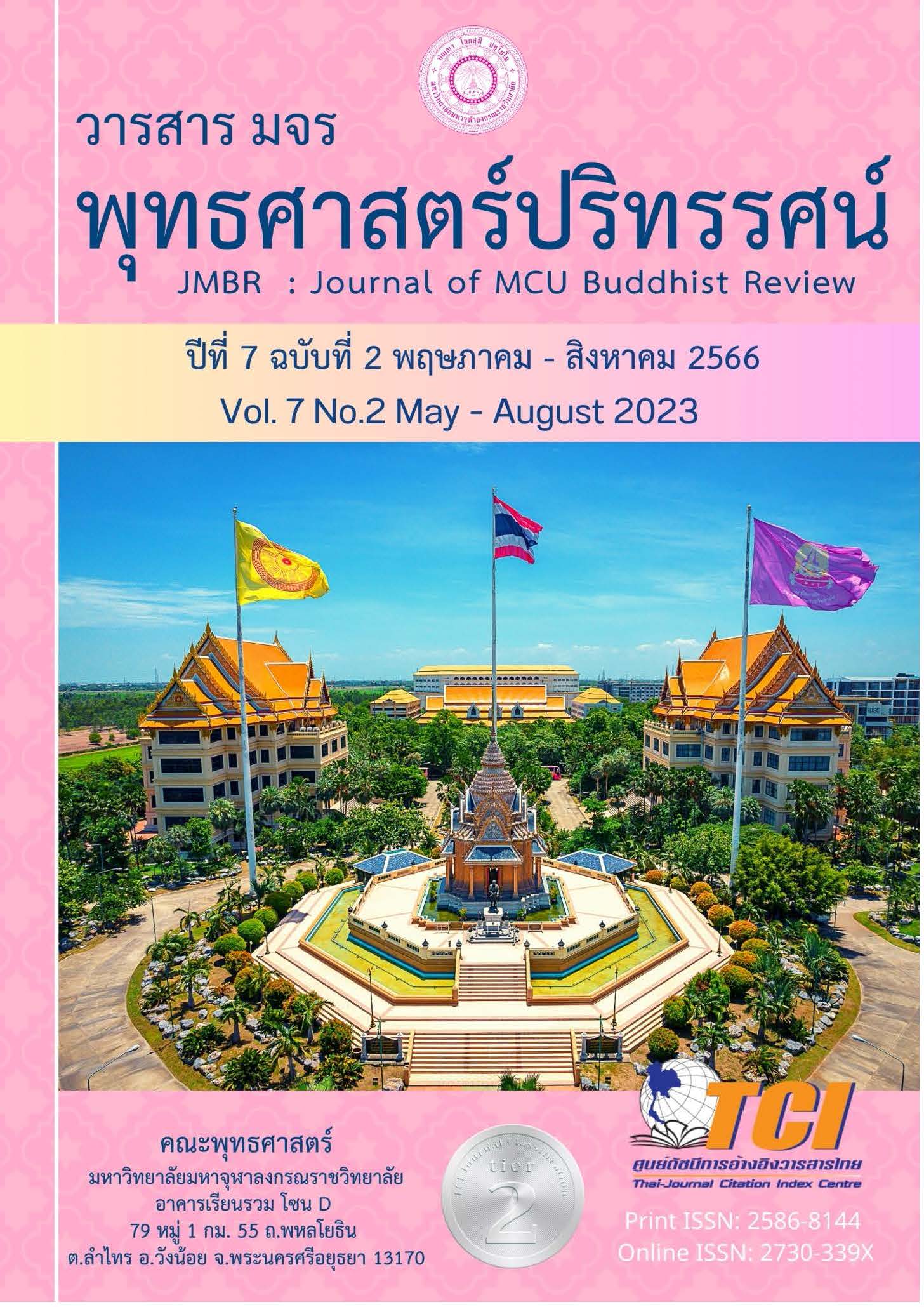การประเมินผลลัพธ์ทางสังคมและพัฒนาตัวชี้วัดเพื่อนำไปสู่การวิเคราะห์ค่าทางการเงินเบื้องต้นผ่านโครงการยกระดับคุณภาพบัณฑิตสู่อัตลักษณ์ด้วยกระบวนการอาสาประชารัฐบนหลักพุทธธรรมของมหาวิทยาลัยราชภัฏอุตรดิตถ์
Main Article Content
บทคัดย่อ
บทความวิชาการนี้มีวัตถุประสงค์เพื่อนำเสนอฐานคิดของการประเมินผลลัพธ์ทางสังคมบูรณาการกับหลักพุทธธรรม และเพื่อพัฒนาตัวชี้วัดนำไปสู่การวิเคราะห์ค่าการเงินเบื้องต้นของโครงการยกระดับคุณภาพบัณฑิตสู่อัตลักษณ์ของมหาวิทยาลัยด้วยกระบวนการอาสาประชารัฐ ผลการศึกษาพบว่า ฐานคิดของการประเมินผลลัพธ์บุรณาการกับหลักพุทธธรรม เป็นแนวคิดและกระบวนการก่อนและหลังการดำเนินโครงการเพื่อวิเคราะห์ผลกระทบทางสังคมที่เกิดจากการโครงการ ซึ่งคำนึงถึงความยั่งยืนของการพัฒนาและความเป็นธรรมแก่กลุ่มเป้าหมายของโครงการบนหลักพุทธธรรม คือ หลักพรหมวิหาร 4 คือ เมตตา กรุณา มุทิตา และอุเบกขา ผลการพัฒนาตัวชี้วัดด้านเศรษฐกิจของโครงการที่เป็นกรณีศึกษา ได้แก่ 1) ตัวชี้วัดด้านเศรษฐกิจ 11.) ระดับบุคคล ประกอบด้วย รายได้ต่อคน (ครัวเรือน)/เดือน และ 1.2) ระดับชุมชน ประกอบด้วย รายได้ต่อคน (ครัวเรือน)/เดือน และรายได้ต่อชุมชนที่ดำเนินในรูปแบบของกลุ่มร่วมกับประชาชนที่เข้าร่วมโครงการ/เดือน และ 2) ตัวชี้วัดด้านสิ่งแวดล้อม 2.1) ระดับบุคคล ประกอบด้วย ต้นทุนที่องค์กรปกครองส่วนท้องถิ่น (อปท.) ต้องลงทุนกับการจัดการขยะที่ต้นทางเพื่อกำจัดขยะ จำนวน 1 กิโลกรัม ต่อคน/ครัวเรือน และ 2.2) ระดับชุมชน ประกอบด้วย ต้นทุนที่องค์กรปกครองส่วนท้องถิ่นต้องลงทุนกับการจัดการขยะที่ต้นทางเพื่อกำจัดขยะ จำนวน 1 กิโลกรัม ต่อคน /ครัวเรือน และผลลัพธ์ทางสังคม พบว่า สามารถบรรลุผลลัพธ์หลักด้านขจัดเหตุปัจจัยของปัญหาที่เกิดขึ้นด้านสังคมมากที่สุด และผลการวิเคราะห์ค่าทางการเงินเบื้องต้นในด้านเศรษฐกิจ พบว่า ระดับชุมชนมีรายได้ 30,500 บาท/61 คน (ครัวเรือน)/เดือน และด้านสิ่งแวดล้อม พบว่า สามารถลดต้นทุนกำจัดขยะ 9,991.80 บาท/ปี การดำเนินโครงการนี้จึงทำให้ชุมชนได้รับผลลัพธ์ทางบวก และนักศึกษาได้ประยุกต์ใช้องค์ความรู้การแก้ไขปัญหาร่วมกับชุมชนในรูปแบบอาสาประชารัฐ จึงเกิดการพัฒนาบัณฑิตที่มีจิตสาธารณะต่อส่วนรวม
Article Details

อนุญาตภายใต้เงื่อนไข Creative Commons Attribution-NonCommercial-NoDerivatives 4.0 International License.
- บทความที่ได้รับการตีพิมพ์เป็นลิขสิทธิ์ของวารสาร มจร พุทธศาสตร์ปริทรรศน์
- ข้อความใดๆ ที่ปรากฎในบทความที่ได้รับการตีพิมพ์ในวารสาร ถือเป็นความรับผิดชอบของผู้เขียนบทความ และข้อคิดเห็นนั้นไม่ถือว่าเป็นทัศนะและความรับผิดชอบของกองบรรณาธิการวารสาร มจร พุทธศาสตร์ปริทรรศน์
เอกสารอ้างอิง
ญาณี แก้วนก. (2564). โครงการพัฒนานวัตกรรมการจัดการขยะพลาสติก.และโฟมแบบมีส่วนร่วมของภาคีเครือข่ายด้วยกระบวนการอาสาประชารัฐบ้านบุ่งวังงิ้ว ตำบลป่าเซ่า อำเภอเมือง จังหวัดอุตรดิตถ์. รายงานวิจัย อุตรดิตถ์: มหาวิทยาลัยราชภัฏอุตรดิตถ์.
ปเนต มโนมัยวิบูลย์ และพรรณนิภา ดอกไม้งาม. (2561). การทบทวนต้นทุนการจัดการขยะและการประเมินตลอดวัฏจักรชีวิตของระบบการจัดการขยะมูลฝอย: หลักการและการดัดแปลงมาใช้กับองค์กรปกครองส่วนท้องถิ่นในประเทศไทย ภายใต้ชุดโครงการประสิทธิภาพและธรรมาภิบาลของนโยบายสาธารณะไทย การวิจัยเพื่อเสริมสร้างนักนโยบายสาธารณะที่ดี (Efficiency and Government of Thai Public Policies). รายงานวิจัย เชียงใหม่: มูลนิธิสถาบันศึกษานโยบายสาธารณะ.
ผู้บริหารคนหนึ่งของกลุ่มขโหยด. (2565). ผู้บริหารกลุ่มขโหยด ตำบลป่าเซ่า อำเภอเมือง จังหวัดอุตรดิตถ์. สัมภาษณ์. 23 มิถุนายน.
พระพรหมคุณาภรณ์ (ป.อ.ปยุตฺโต). (2552). เครื่องวัดความเจริญของชาวพุทธ (อารยวัฑฒิ). กรุงเทพฯ: บริษัทสหธรรมิก จำกัด.
พระไพศาล วิสาโล. (2549). เครือข่ายจิตอาสา ใน คู่มือจิตอาสาโครงการอาสาเพื่อในหลวง. กรุงเทพฯ: ศูนย์ประสานงานเครือข่ายจิตอาสา.
สุพัตตรา ตันติจริยาพันธ์. (2564). การนำแนวคิดการประเมินผลลัพธ์ทางสังคม (Social Impact Assessment: SIA) เพื่อวัดผลสำเร็จของโครงการสาธารณะเชิงพื้นที่. ใน การประชุมระดับชาติ ครั้งที่ 13 การวิจัย สร้างดุลยภาพชีวิตเพื่อรองรับ New Normal, 1906-1916. นครปฐม: มหาวิทยาลัยราชภัฏนครปฐม.
สุพัตตรา ตันติจริยาพันธ์ และคณะ. (2564). โครงการสังเคราะห์ โครงการยกระดับคุณภาพบัณฑิตสู่อัตลักษณ์ของมหาวิทยาลัยด้วยกระบวนการอาสาประชารัฐ (B10). รายงานวิจัย อุตรดิตถ์: มหาวิทยาลัยราชภัฏอุตรดิตถ์.
Becker, H.A. (2001). Social impact assessment, European Journal of Operational Research, 128(2), 311-321.
Department of Planning, Industry and Development. (2021). Social Impact Assessment. Retrieved 25 June 2021 from https://www.planning.nsw.gov.au/Policy-and-Legisla tion/Under-review-and-new-Policy-and-Legislation/Social-Impact-Assessment.
Global Partnership for Education. (2020). 21st Century Skills: What potential role for the Global Partnership for Education? A Landscape Review. Retrieved 25 June 2021 from https://www.globalpartnership.org/sites/default/files/document /file/2020-01-GPE-21-century-skills-report.pdf.
International Association for Impact Assessment. (2021). SOCIAL IMPACT ASSESSMENT: Guidance for assessing and managing the social impacts of projects. Retrieved 25 June 2021 from https://www.iaia.org/uploads/pdf/SIA_Guidance_Document_IAIA.pdf.
Kay, K. (2010). 21st Century Skills: Why the Matter, What They are, and How We Get There. In Bellanca, J. & Brandt, R. (Eds.), 21st Century Skills: Rethinking How Students Learn. Bloomington, In: Solution Tree Press.
Vanclay, F. (2003). International Principles For Social Impact Assessment. Impact Assessment and Project Appraisal. 21(1), 5-12.
Vanclay, F., Esteves, A. M., Aucamp, I., & Franks, D. (2015). Social Impact Assessment: Guidance for assessing and managing the social impacts of projects. Fargo ND: International Association for Impact Assessment.


